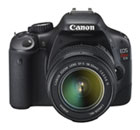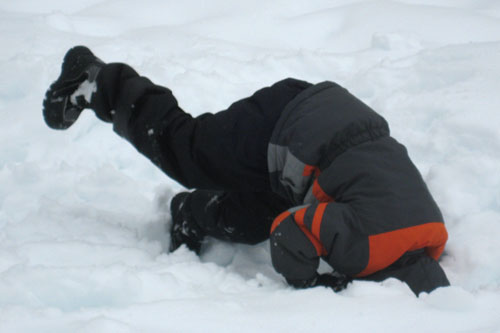
February 28, 2010
Having trouble viewing this newsletter? Read the latest issue online at
https://www.digital-slr-guide.com/dslr-news.html or read back issues
If someone you know has forwarded you this newsletter and you've enjoyed it, subscribe now to receive the next issue when it's published.
DSLR News - February 2010 I'm referring to the annual Photo Marketing Association (PMA) trade show that took place this month in Anaheim, California (home to Disneyland - for those not from the U.S. West Coast). PMA is the event where camera manufacturers announce new cameras that will be available for purchase soon, and show of new technology that is still under development. Some of the cameras shown at PMA are merely concepts under glass, and some may never make it into the hands of consumers. But a surprising number do eventually make their way into the consumer market, although it can be many months before a prototype camera is ready for real-world usage. Since PMA is such a big event - and often a sign of what technology we'll be seeing soon - I've devoted the first half of this newsletter to a review of what's been announced at the show...and what hasn't. Sometimes the lack of announcements from a manufacturer can mean that the company is planning new cameras, but doesn't yet have anything that's ready for the world to see. It's worth nothing that PMA is not the only big event this year - in September a second big conference called Photokina will kick off in Cologne, Germany. If manufacturers don't tip the press off about what new cameras they have planned at PMA, then they'll often tell all for Photokina. You can find updates and new camera announcements on the Digital SLR for Starters Blog, the DSLR Guide Facebook page, and Twitter. |
In This Issue
Latest SLR Guides
Canon Rebel T1i
Nikon D5000
Nikon D90
Nikon D60
Canon Rebel XSi
Pentax K20D
Canon 40D
Olympus E-510
Nikon D80
Canon Rebel xTi
Nikon D40
Digital SLR Terms
Megapixels
Stabilization
ISO / Image Noise
Sensor Dust
Crop Factor
RAW vs. JPG
Continuous Photos
Autofocus Points
Aspect Ratio
Lens Terms
Focal Length
Prime vs. Zoom
Maximum Aperture
First vs. Third Party
SLR Lens Features
Canon Lens Glossary
Nikon Lens Glossary
|
Stay Updated!
The Digital SLR Guide is now on Facebook. If you're on Facebook, drop on by to get frequent updates about new digital SLR cameras and photo techniques.2010 DSLR Trends
If nothing else, PMA often makes it clear where digital camera technology is headed.Whether it's the release of new cameras, or the announcements of prototypes and concept models, if you look at the overall trends you start to see a bigger picture of what technology might be coming next.
I'll break down what each company announced for the PMA show, and what this might mean for those interested in DSLR cameras in 2010.
CANON

Canon announced the arrival of their next Digital Rebel: the T2i 550D.
As a successor to the T1i 500D (the first Canon Digital Rebel with a video capture mode), the T2i enhances the video capture mode substantially.
With the T2i you have manual control over exposure settings during video capture, you can autofocus during video capture and there's a plug for an external stereo microphone for improved audio quality.
Besides this, the T2i replicates all of the T1i's other features, but it ups the megapixel count from 15 to 18.
This camera clearly shows that Canon has fully embraced the digital-SLR-as-video-camera mentality, and wants to continue to improve upon this feature. Expect the release of more hybrid still/video cameras from Canon in 2010.
NIKON
Less eager to jump on the DSLR video bandwagon (although the first company to produce a DSLR that could capture video - the D90) Nikon spent a lot of time in 2009 focusing on high ISO image quality.
It appears that this will continue to be the trend for 2010, and if Nikon can continue to minimize noise at high ISO settings they will have a camera that can pretty much take clear pictures in the dark.
This is not to say that video is off the table - you can expect Nikon to release some new cameras in 2010 with the ability to capture video.
More Info: PMA Interview With Nikon
OLYMPUS

The E-PL1 is another Micro 4/3rds camera, also called an interchangeable lens digital camera (ILDC) or a mirrorless DSLR (micro 4/3rds cameras don't include a viewfinder and mirror system like "true" DSLRs).
And even though Olympus appears to have completely forgotten about their DSLR line (in favor of the Micro 4/3rds format) this is not the case - expect to see some new "true" DSLRs from Olympus this year.
More Info: PMA Interview With Olympus
PENTAX
There hasn't been a lot of news from Pentax lately, so my guess is as good as yours about what they are going to release in 2010.
Video will most likely be included, since it found its way into the K-7 and the K-x of 2009.
One thing I can guess: Pentax cameras offer great value for money since they have to compete with a lot of other significantly larger players in the DSLR market.
I expect Pentax will continue to offer competitive cameras at lower prices, providing consumers with a lot of features for their hard-earned currency.
SAMSUMG
For a long time, Samsung was cranking out Pentax clones that differed very little from alternative Pentax models except for brand name.
Now Samsung is going in a different direction, focusing their attention on the mirrorless DSLR market.
With the recent announcement of the Samsung NX10, it appears that Samsung has seen the opportunity in this new market and is preparing to offer cameras that appeal people who want better image quality but aren't happy with the size and bulk of digital SLRs.
More Info: PMA Interview With Samsung
SONY
Sony was by far the most vocal manufacturer at the show, but had no specific cameras to announce nor any release dates.
Some concept models shown make it clear that Sony intends to challenge Panasonic and Olympus in the micro 4/3rds market with their own compact interchangeable lens digital cameras (ILDCs).
Sony also appears to be embracing video capture and will probably release some DSLRs in 2010 that include this feature (which was notably absent from all of their 2009 models).
Finally, some high-end lens announcements show that Sony would also like professional photographers to embrace their cameras. This is a very tough sell, since so many pro shooters have been faithfully using Canon or Nikon cameras for years.
More Info: Sony PMA 2010 Press Release
Beginner Digital SLR Lessons
- Dramatically improve the photos you take
- Master the controls of any digital SLR
- Learn at your own pace
- All lessons available as PDF files
- Print the lessons for offline reference
- Ask me questions
What's New
- Added the T2i to the Canon Digital SLR page
- Added the T2i to the 15 megapixel DSLR page
Quick Photo Tip
Due to overwhelming consensus from fans of the Digital SLR Guide's Facebook page, this month I'll be talking about something that appears to be an issue for many: how to photograph moving subjects in low light.Let's cover the important point first: it all comes down to shutter speed.
If your shutter speed is too slow when you're taking photos of moving subjects, you wind up with a very blurry subject. When taking pictures of active subjects in dim light your one and only goal is to INCREASE your shutter speed as much as possible.
There are two ways to maximize shutter speed:
- Open your lens aperture to its maximum
- Increase the ISO setting
The lens aperture is the size of the opening in your lens - wider apertures let in MORE light and will therefore increase your shutter speed. Wide lens apertures are represented by small numbers like f/3.5 or f/2.8.
The ISO setting determines how fast your sensor absorbs light. Higher ISO settings mean that the sensor is absorbing light FASTER which increases your shutter speed (but a high ISO setting will also introduce noise into your photos).
So - what's the best way to maximize image quality and also ensure that your subjects turn out nice and sharp?
- Set your camera to Aperture Priority mode (this lets you choose the aperture while the camera picks a matching shutter speed)
- Spin the main control dial of your camera until the aperture number is as small as it can get
- With the camera to your eye, press down halfway on the shutter release button - this will engage the autofocus and will also show you what shutter speed the camera has selected to go with the aperture
- If the shutter speed is slow - say, 1/60th of a second - then increase the ISO setting by one level (if it's set to 100 go to 200, if at 400 go to 800, etc.)
- Press halfway on the shutter release again to see what shutter speed the camera has picked now
- If you feel the shutter speed is fast enough, then don't increase ISO any further - this will keep the noise in your photos at a minimum
- If the shutter speed still isn't fast enough, keep upping the ISO until the shutter speed looks good
Once you find the right settings for aperture, shutter speed and ISO, then you can fire away without having to adjust settings any further.
SPECIAL NOTE #1
Not all lenses have the same widest aperture value - also called the maximum aperture of the lens.
For example, some people following the steps above may find that they can only get their aperture as wide as f/4 while others will be able to go all the way to f/2.8.
The maximum aperture of most kit lenses is f/3.5.
Let's say that you've diligently followed the steps above using a lens with a max aperture of f/4. You've found that even at ISO 6400 (which is quite grainy) you're shutter speed still isn't fast enough.
I hate to say it, but in this case your only option is to purchase a different lens with a wider maximum aperture.
SPECIAL NOTE #2
The maximum aperture of some lenses will CHANGE as you zoom the lens from wide angle to telephoto - this is called VARIABLE maximum aperture.
For example, most kit lenses have a variable max aperture that ranges from f/3.5 to f/5.6. The max aperture is based on the focal length of the lens:
- At 18mm (wide angle) the maximum aperture is f/3.5
- At 55mm (telephoto) the maximum aperture narrows to f/5.6
What do you do if your lens has a variable maximum aperture? Follow the same steps as above, but:
- In aperture priority mode, select the NARROWER of the two apertures
- Increase ISO until your shutter speed is fast enough
- When done, select the widest aperture your lens will allow
The reason for this is simple: if your shutter speed is fast enough at the narrower aperture setting, then it will only get FASTER when the aperture of the lens gets wider. By matching your shutter speed to the more narrow aperture, you're ensuring that you can zoom in and out without having to adjust your camera settings at all.
SPECIAL NOTE #3
Image stabilization (whether in your camera or lens) is of no use for this situation.
This is because image stabilization only helps to stabilize CAMERA motion. It's great if you want to use slow shutter speeds and your subject is not moving around.
But if your subject IS in motion, the only thing that's going to capture a clear image is a fast shutter speed.
EXAMPLE
|
Aperture: f/3.5 ISO: 100 Shutter Speed: 1/6 Notes: In image #1 the shutter speed is much too slow - the entire image is one big blur. |
 |
|
Aperture: f/3.5 ISO: 400 Shutter Speed: 1/20 Notes: Increasing ISO to 400 increases shutter speed to 1/20 - still not fast enough to prevent motion blur. |
 |
|
Aperture: f/3.5 ISO: 1600 Shutter Speed: 1/80 Notes: Taking the ISO up to 1600 gets me a useable 1/80th of second, enough to get a clear shot of my daughter but only because she's standing fairly still. |
 |
ADDITIONAL READING
I request tip ideas on the Digital SLR Guide's Facebook page - if you'd like to suggest ideas for this newsletter, then become a fan.
Picture Stories

For once, I can't take credit for an image in this newsletter - the one above was captured by my wife during a recent trip to the snow.
This was about the third time that my son had seen snow and the previous two times were pretty disastrous - about 5 minutes out in the cold air and he decided that he'd rather just sit in the car.
This time I think that he finally appreciated how much fun romping in the snow can be - or perhaps he was finally warm enough to have a good time.
After a couple of runs down the hill on the sled, he decided that he'd rather dig a hole in the snow. And then, in one of those odd moments that can only happen with a young child, he tried sticking his head in the hole he'd just dug.
I think that he was pretending to be an ostrich.
Whatever the reason, my wife was there to capture it with the camera, and this illustrates a good point about digital photography in general: you never know WHEN a spontaneous photo opportunity will present itself.
Part of the reason why professional photographers are able to capture those once-in-a-lifetime moments is because they are ALWAYS carrying a camera.
If you're willing to tote yours around more often, chances are you're going to see some amazing things that you can preserve forever with a photo.
Photo Links
Other Photography Sites
- Betterphoto - a wealth of photography learning opportunities
- Flickr - share your photos with friends and others
- Photo.net - plenty of learning resources and examples of exceptional photography
- Borrowlenses - rent lenses to use on your digital SLR before you spend tons of money on one
- Photojojo - tons of photography do-it-yourself (DIY) projects
- Viewpoints.com - read product reviews from other consumers like yourself
Great Photo Blogs
- Digital Photography School - hundreds of photo tips and techniques
- Strobist - everything you ever wanted to know about lighting with external flash
- Joe McNally - get the "behind-the-scenes" thought process from a professional photographer
Recommended Digital SLR Retailers
(These are the three online stores that I use to purchase all of my digital SLR photography gear)In Conclusion
I've come to the conclusion that I need a way to dictate to my computer and have it type for me - there's just too much to write down right now and not enough time to do it.Despite the flurry of news surrounding PMA, I've been making great progress on the next set of Digital SLR Lessons. I've got all 5 lessons pretty much written, but now I need to go back and add in a LOT of sample photos.
An illness in February made me lose a week of time, so I'm not sure if the lessons will be 100% done by the end of next month (that was my original goal) but if not you can definitely expect them to be available in April.
Once those are done, I'll get some new cameras in my hands so that I can post some more in-depth guides.
Happy picture-taking!
--Chris Roberts, Your Digital SLR Guide
